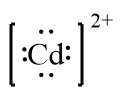So let's take a look at the rules for drawing a Lewis symbol. First thing we need to realize is that we have our element symbol. So here hydrogen is H, aluminum is Al, and then we have our surrounding dots in red. Now we're going to see there are some exceptions to this, but a vast majority of these surrounding dots are red. What we need to realize here is that when we're talking about our element symbol, it represents that element's nucleus as well as its core electrons, and we'll say those core electrons are green. The surrounding dots represent the valence electrons for that particular element.
Now if we take a look, we see that lithium is in Group 1A. Since it's a main group element, it has one valence electron, which is represented by this one dot. If we look at carbon, carbon is the main group element. It's in Group 4A, so it has four dots around it. Now the way we tend to do it is we add our first dot here at the top, and as we add more and more dots, we start adding them clockwise. So here goes one for beryllium. Boron has three, so we add 1 here, and carbon has four, so we add another one here. When we get to nitrogen. Now we start pairing them up and that's how we draw our Lewis dot electrons.
Now if we take a look at hydrogen and helium, their electrons are green, which means that they represent their core electrons. Remember, hydrogen and helium only have one electron shell. Because they have that one electron shell, you could say it represents their core electrons or even their valence electrons. OK, so they're a little bit of an exception to what we're accustomed to seeing. If we take a look at our transition metals, remember we said for transition metals, we looked at their S&D electrons to determine the number of valence electrons. So if we looked here at Titanium, its electron configuration is argon 4S23D2. It would have 4 valence electrons total from adding the S&D electrons.
Now you'll need to remember the rules that we went over in terms of electron configurations to know what I'm talking about. If you haven't, I highly suggest you go back and take a look at electron configurations. If we look at if we look at manganese, manganese would be argon 4S23D5. So that would be 7 valence electrons. But joules, what if I don't want to do the electron configuration? Well, you don't necessarily have to because here's a trick. The number of valence electrons for these transition metals. You can determine them by looking at their group number. SO3B is group three, group 1B is group 11. These numbers here also correspond to the number of valence electrons each of the transition metals have.
So if you don't want to waste your time in writing out the electron configuration of let's say for example zinc, Zinc is in Group 12 which also equals the number of valence electrons because if we look we have 2 S electrons plus 10D electrons which adds up to 12. So just remember these little key things when it comes to the electron dot symbols for each one of these elements from the periodic table.














